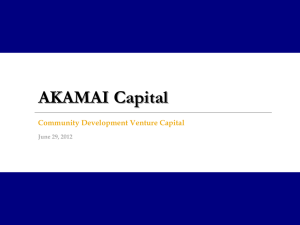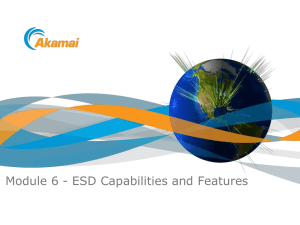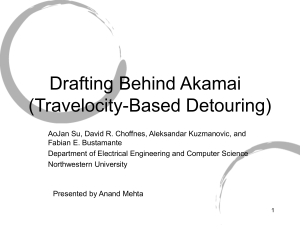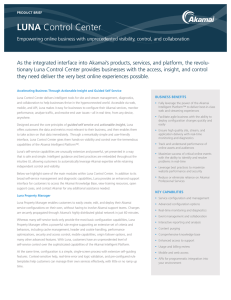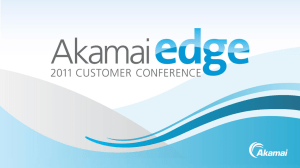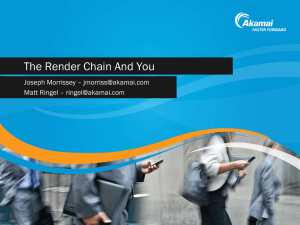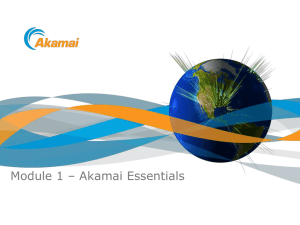ESD_Module 4_Refreshing Akamai..
advertisement
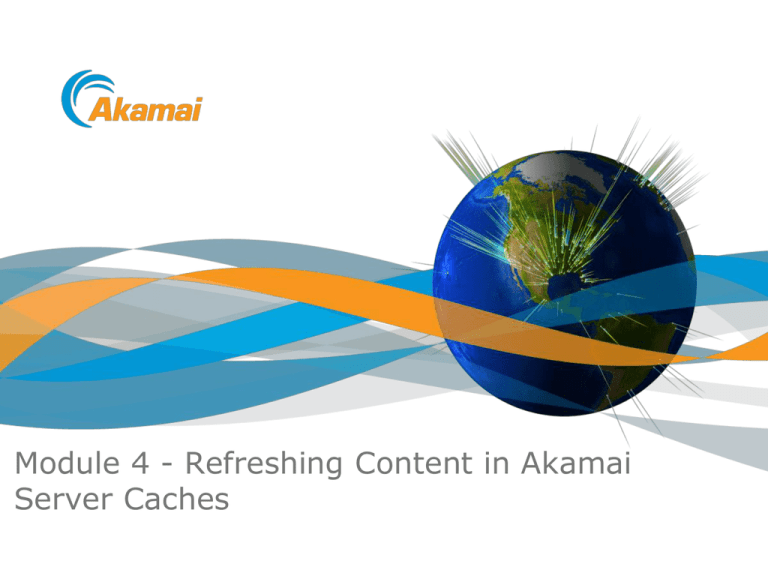
Module 4 - Refreshing Content in Akamai Server Caches Objectives After completing this module, you will be able to: • identify the mechanisms available to refresh your content cached in Akamai edge servers. • use the tools that Akamai provides to refresh content. • plan for origin downtime. Powering a Better Internet ©2011 Akamai Introduction When a client request is made, Akamai edge servers contact the origin under the following circumstances: • When the requested objects are not in cache • If the requested object is marked as no store • It the time to live or TTL of the object has expired Powering a Better Internet ©2011 Akamai Cache Refreshing Mechanisms To manually refresh content and not wait for TTL expiration, Akamai provides two basic mechanisms: 1. Purge- based 2. Invalidation- based Powering a Better Internet ©2011 Akamai Purge-based Mechanisms • On purging content from the Akamai network, edge servers will reretrieve content from the origin on the next request. • The Akamai edge server: • removes the object from cache. • on the next request, sends a full HTTP GET request to the origin to fetch objects. • refreshes the cache with fresh content. Powering a Better Internet ©2011 Akamai Invalidation-based Mechanisms • Invalidation-based mechanisms cause Akamai edge servers to revalidate the freshness of content with an IMS GET on the next client request. • On receiving a client request, edge servers: • send an IMS Get request to the origin to fetch objects. • remove and replace cached object only if newer version is available Powering a Better Internet ©2011 Akamai Tools to Refresh Content Akamai provides these tools on Akamai EdgeControl to purge and invalidate content: 1. Content Control Utility (CCU) 2. Enhanced Content Control Utility (ECCU) Powering a Better Internet ©2011 Akamai Content Control Utility • Allows you to specify the objects to remove from cache by URL, ARL, or by CP Code. • Benefits: • Easy to use interface • Requests can be removal or invalidation based • Provides the option of receiving email notifications of the result of your refresh actions • Disadvantage: You must specify each object to be removed; you cannot specify a directory by wildcard. Powering a Better Internet ©2011 Akamai Accessing the CCU Powering a Better Internet ©2011 Akamai Using the CCU Powering a Better Internet ©2011 Akamai Using the CCU (Cont…) Powering a Better Internet ©2011 Akamai Using the CCU – Purging by CP Code • Be mindful that removing or invalidating all objects under a CP code can cause high load on your origin server. Powering a Better Internet ©2011 Akamai CCU – Important Points to Remember • Purge and invalidation-based requests using the CCU take approximately 10 minutes to take effect. • Files submitted for CCU requests should not contain more than 100 URLs each less than 400 characters in length. • If you receive a “Request Entity Too Large” error, split your file into smaller files and try again. • You can submit any number of files containing about 100 URLs, but there cannot be more than 10,000 outstanding requests at any one time. • If you receive a Code 332 error, which indicates you have exceeded this limit, wait for about 10 minutes and try again. Powering a Better Internet ©2011 Akamai Content Control Utility API The CCU API: • can be used to write programs that submit a list of cached objects to be removed from the Akamai network. • uses SOAP, HTTP or HTTPS, and either the removal-based or invalidation-based refresh method. • is typically used in one of two ways: • to develop a GUI for those who manage Web content, rather than providing access to Akamai EdgeControl. • to integrate the API into a content management system. Powering a Better Internet ©2011 Akamai Enhanced Content Control Utility • ECCU provides for invalidation-based refresh by rules such as date or time, path, file extension, or more complex criteria. • There are three ways to use the ECCU: • As a web interface on Akamai EdgeControl • File upload, using a function on Akamai EdgeControl • ECCU Publisher or Publish ECCU Note: • Invalidation-based refreshing is the only option for refreshing content if you are using the ECCU. • An invalidation based request will take approximately 30-40 minutes to complete. Powering a Better Internet ©2011 Akamai Accessing the ECCU Powering a Better Internet ©2011 Akamai Using the ECCU Powering a Better Internet ©2011 Akamai Comparison of Tools Tool Description CCU A web page on Akamai EdgeControl that allows you to specify objects to remove from cache, or to remove objects by CP Code. CCU API Same as the CCU UI, but a SOAP-based API. ECCU A web page on Akamai EdgeControl that allows you to specify refreshing objects by rules involving path and file extensions. ECCU File Upload Using the ECCU Web UI, you can upload ECCU files containing rule-based instructions beyond path and extension. ECCU Publisher An EdgeControl Web Service SOAP-based API that allows you to upload ECCU files. Powering a Better Internet ©2011 Akamai When to Use the CCU and ECCU CCU: • For refreshing specific URLs • If there are more than about 10,000 objects, - allows you to purge by CP code ECCU: • When you can identify objects by directory or file extension. Important: Ensure that you update the content on your origin server before submitting a content refresh request Powering a Better Internet ©2011 Akamai Lab 5 - Refreshing Cache Powering a Better Internet ©2011 Akamai


